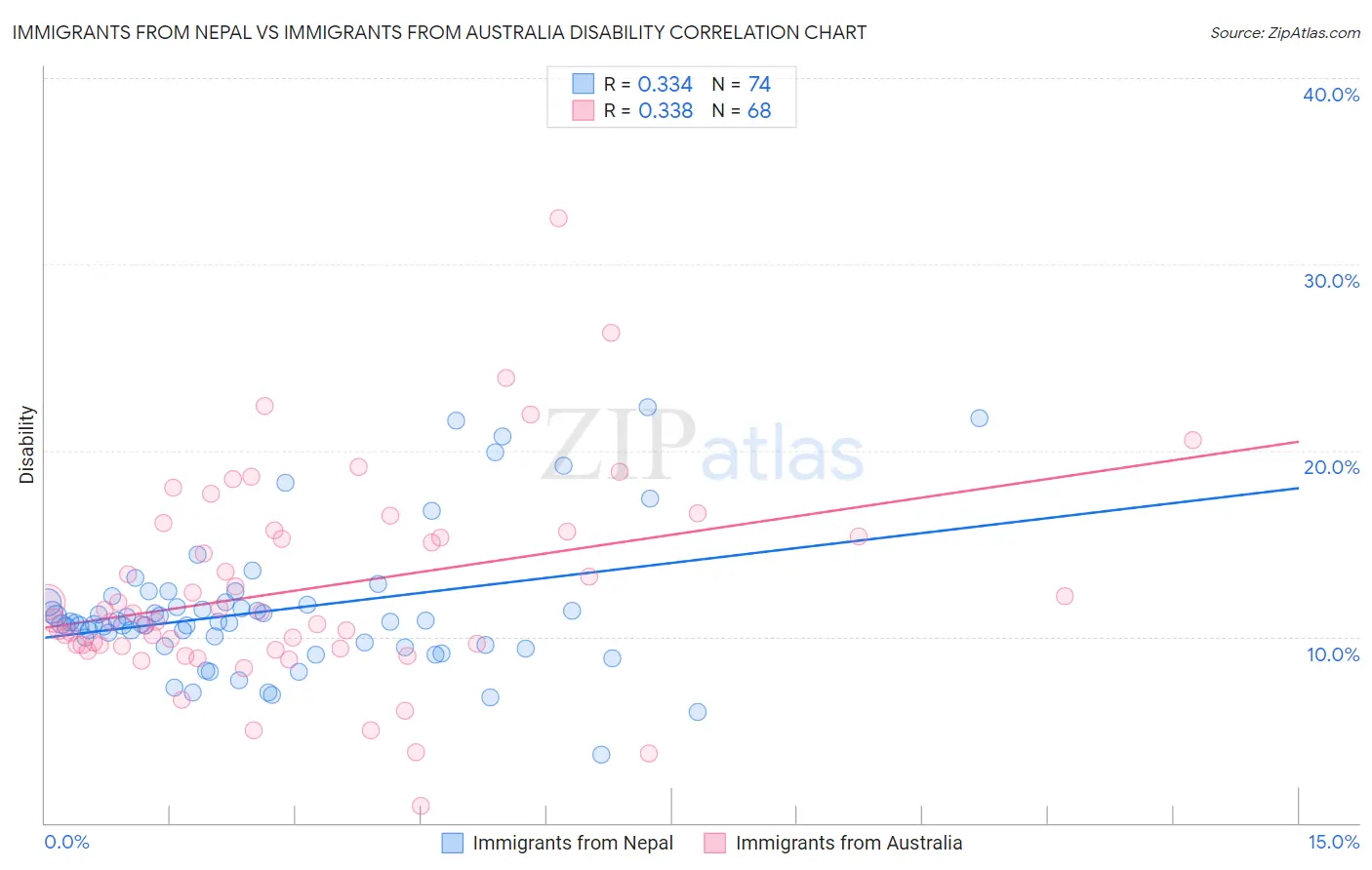Immigrants from Nepal vs Immigrants from Australia Disability
COMPARE
Immigrants from Nepal
Immigrants from Australia
Disability
Disability Comparison
Immigrants from Nepal
Immigrants from Australia
10.8%
DISABILITY
99.9/ 100
METRIC RATING
42nd/ 347
METRIC RANK
10.8%
DISABILITY
99.9/ 100
METRIC RATING
41st/ 347
METRIC RANK
Immigrants from Nepal vs Immigrants from Australia Disability Correlation Chart
The statistical analysis conducted on geographies consisting of 186,790,977 people shows a mild positive correlation between the proportion of Immigrants from Nepal and percentage of population with a disability in the United States with a correlation coefficient (R) of 0.334 and weighted average of 10.8%. Similarly, the statistical analysis conducted on geographies consisting of 227,205,493 people shows a mild positive correlation between the proportion of Immigrants from Australia and percentage of population with a disability in the United States with a correlation coefficient (R) of 0.338 and weighted average of 10.8%, a difference of 0.10%.

Disability Correlation Summary
| Measurement | Immigrants from Nepal | Immigrants from Australia |
| Minimum | 3.7% | 0.92% |
| Maximum | 22.3% | 32.5% |
| Range | 18.7% | 31.6% |
| Mean | 11.4% | 12.6% |
| Median | 10.8% | 11.1% |
| Interquartile 25% (IQ1) | 9.6% | 9.5% |
| Interquartile 75% (IQ3) | 11.9% | 15.5% |
| Interquartile Range (IQR) | 2.3% | 6.0% |
| Standard Deviation (Sample) | 3.7% | 5.5% |
| Standard Deviation (Population) | 3.6% | 5.4% |
Demographics Similar to Immigrants from Nepal and Immigrants from Australia by Disability
In terms of disability, the demographic groups most similar to Immigrants from Nepal are Israeli (10.8%, a difference of 0.050%), Cambodian (10.8%, a difference of 0.14%), Mongolian (10.8%, a difference of 0.14%), Immigrants from Japan (10.8%, a difference of 0.15%), and Afghan (10.8%, a difference of 0.25%). Similarly, the demographic groups most similar to Immigrants from Australia are Cambodian (10.8%, a difference of 0.040%), Mongolian (10.8%, a difference of 0.040%), Afghan (10.8%, a difference of 0.15%), Israeli (10.8%, a difference of 0.15%), and Immigrants from Japan (10.8%, a difference of 0.25%).
| Demographics | Rating | Rank | Disability |
| Immigrants | Egypt | 100.0 /100 | #31 | Exceptional 10.6% |
| Paraguayans | 100.0 /100 | #32 | Exceptional 10.6% |
| Immigrants | Kuwait | 100.0 /100 | #33 | Exceptional 10.7% |
| Immigrants | Ethiopia | 100.0 /100 | #34 | Exceptional 10.7% |
| Immigrants | Indonesia | 100.0 /100 | #35 | Exceptional 10.7% |
| Ethiopians | 100.0 /100 | #36 | Exceptional 10.7% |
| Turks | 100.0 /100 | #37 | Exceptional 10.7% |
| Afghans | 99.9 /100 | #38 | Exceptional 10.8% |
| Cambodians | 99.9 /100 | #39 | Exceptional 10.8% |
| Mongolians | 99.9 /100 | #40 | Exceptional 10.8% |
| Immigrants | Australia | 99.9 /100 | #41 | Exceptional 10.8% |
| Immigrants | Nepal | 99.9 /100 | #42 | Exceptional 10.8% |
| Israelis | 99.9 /100 | #43 | Exceptional 10.8% |
| Immigrants | Japan | 99.9 /100 | #44 | Exceptional 10.8% |
| Immigrants | Peru | 99.9 /100 | #45 | Exceptional 10.8% |
| Tongans | 99.9 /100 | #46 | Exceptional 10.8% |
| Taiwanese | 99.9 /100 | #47 | Exceptional 10.8% |
| Soviet Union | 99.9 /100 | #48 | Exceptional 10.9% |
| Vietnamese | 99.9 /100 | #49 | Exceptional 10.9% |
| Immigrants | Saudi Arabia | 99.9 /100 | #50 | Exceptional 10.9% |
| Peruvians | 99.8 /100 | #51 | Exceptional 10.9% |